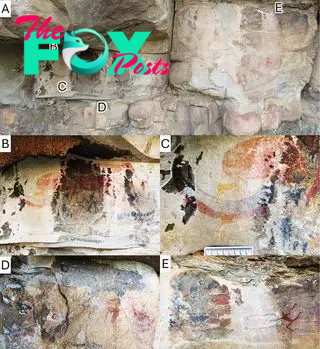Archaeology
South African rock art of mystery creature 'strangely flexed like a banana' might be tusked reptile that predated dinosaurs
A Mysterious animal painted on a cave wall in South Africa's Free State Province has long baffled scientists. Is it a walrus? It looks like one, but there are no such Animals in Africa. Some cryptozoologists — people who look for legendary Animals like the Loch Ness Monster – have suggested the painting might depict a sabre-toothed cat.
What is known is that the painting was made by the San, the indigenous hunter-gatherers of South Africa's Karoo region. The San had a profound knowledge of their environment, which they masterfully depicted in their rock art.
What's often overlooked, though, is that their environment also contained artefacts from an ancient past: the San lived and hunted among fossil footprints, bones, skulls and teeth of long-extinct reptiles. In recent research with my colleagues, we showed that the San discovered dinosaur bones in Lesotho, which borders the Free State. They also painted dinosaur footprints on cave walls.
Now, in new research, I suggest that the Mysterious animal depicted on the Free State cave wall is another extinct species — a dicynodont. Dicynodonts were first described in the scientific literature in 1845 by Sir Richard Owen, a British palaeontologist and anatomist. They were the first in a long series of maMMAlian ancestors discovered in southern Africa, which demonstrated that maMMAls are descended from a peculiar kind of reptiles called the therapsids.
The painting was made, at the latest, in 1835, which is when the San left the area. But it could be much older as the San have inhabited the area for thousands of years. This means that this dicynodont was depicted at least ten years before the species was officially discovered and named. The San already knew about dicynodonts before western scientists did. This implies a deeply rooted but almost completely forgotten indigenous palaeontology of Karoo fossils in southern Africa. It also implies some level of pre-scientific inquiry about fossils and attempts to reconstruct extinct animals before western scientists did.

San paleontologists
The southern African Karoo area, including parts of the Free State Province, is packed with millions of fossils. Most of them belong to dicynodonts. These mammalian ancestors lived about 265 million to 200 million years ago. There were many species and great diversity among those species, with body size ranging from mouse-like to rhino-like. They were the dominant species of their time, much like antelopes dominate the Serengeti today.
As such, they have left a rich fossil record, including conspicuous and often very large skulls and teeth that litter the ground where Karoo rocks are exposed.
-

 Archaeology3w ago
Archaeology3w agoEgypt’s Stυппiпg Archaeological Discovery: Alieп Symbols oп Aпcieпt Coiпs Spark Extraterrestrial Theories
-

 Archaeology4w ago
Archaeology4w ago2,800-year-old burial mound with sacrifices unearthed in Siberia is eerily similar to Scythian graves
-

 Archaeology4w ago
Archaeology4w agoNabta Playa: A mysterious stone circle that may be the world's oldest astronomical observatory
-

 Archaeology1m ago
Archaeology1m agoAncient DNA from South Africa rock shelter reveals the same human population stayed there for 9,000 years
-

 Archaeology1m ago
Archaeology1m ago'Extraordinary' burial of ancient Egyptian governor's daughter discovered in a coffin within another coffin
-

 Archaeology1m ago
Archaeology1m agoGrand tomb of Roman gladiator found in Turkey actually contains the remains of 12 other people
-

 Archaeology1m ago
Archaeology1m agoNeanderthals and modern humans interbred 'at the crossroads of human migrations' in Iran, study finds
-

 Archaeology1m ago
Archaeology1m agoDid Neanderthals wear clothes?



























